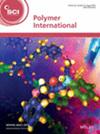求助PDF
{"title":"Polyhydroxybutyrate/poly(ε-caprolactone)-based electrospun membranes loaded with amoxicillin-potassium clavulanate halloysite nanotubes for biomedical applications","authors":"Deepak Verma, Manunya Okhawilai, Nangan Senthilkumar, Natesan Thirumalaivasan, Aran Incharoensakdi, Hiroshi Uyama","doi":"10.1002/pi.6700","DOIUrl":null,"url":null,"abstract":"<p>Biopolymers exhibit distinct properties for biomedical applications. Different biopolymer classes are utilized for various applications, for example antibacterial properties, drug delivery, tissue engineering, tissue scaffolds etc. In the present investigation, a nano-bioengineering approach was followed to prepare polyhydroxybutyrate and polycaprolactone polymer-based drug-loaded halloysite nanotube electrospun membranes for biomedical applications. Functionalized halloysite nanotubes ((3-aminopropyl)triethoxysilane acid treated halloysite nanotubes) at different weight percentages (1, 3, 5 and 7 wt%) were loaded with a broad-spectrum antibiotic amoxicillin trihydrate-potassium clavulanate, incorporated into the electrospun membranes, and characterized by different techniques such as XRD, FTIR, SEM, TEM and TGA. Different physical and mechanical properties were evaluated, such as porosity, water uptake, water vapor transmission rate, wettability and tensile properties. The developed membranes exhibited good <i>in vitro</i> biological properties, for example antibacterial, effective cell migration and less toxicity, as confirmed by disk diffusion, MTT (3-(4,5-dimethylthiazolyl-2)-2,5-diphenyltetrazolium bromide) and cell scratch assays. A sustained drug release profile was observed from all the developed membranes. Overall results on the characterization of the developed membranes confirm the suitability of their use for different biomedical applications and as a wound dressing application. © 2024 Society of Chemical Industry.</p>","PeriodicalId":20404,"journal":{"name":"Polymer International","volume":"74 1","pages":"54-65"},"PeriodicalIF":2.9000,"publicationDate":"2024-10-01","publicationTypes":"Journal Article","fieldsOfStudy":null,"isOpenAccess":false,"openAccessPdf":"","citationCount":"0","resultStr":null,"platform":"Semanticscholar","paperid":null,"PeriodicalName":"Polymer International","FirstCategoryId":"92","ListUrlMain":"https://onlinelibrary.wiley.com/doi/10.1002/pi.6700","RegionNum":4,"RegionCategory":"化学","ArticlePicture":[],"TitleCN":null,"AbstractTextCN":null,"PMCID":null,"EPubDate":"","PubModel":"","JCR":"Q2","JCRName":"POLYMER SCIENCE","Score":null,"Total":0}
引用次数: 0
引用
批量引用
Abstract
Biopolymers exhibit distinct properties for biomedical applications. Different biopolymer classes are utilized for various applications, for example antibacterial properties, drug delivery, tissue engineering, tissue scaffolds etc. In the present investigation, a nano-bioengineering approach was followed to prepare polyhydroxybutyrate and polycaprolactone polymer-based drug-loaded halloysite nanotube electrospun membranes for biomedical applications. Functionalized halloysite nanotubes ((3-aminopropyl)triethoxysilane acid treated halloysite nanotubes) at different weight percentages (1, 3, 5 and 7 wt%) were loaded with a broad-spectrum antibiotic amoxicillin trihydrate-potassium clavulanate, incorporated into the electrospun membranes, and characterized by different techniques such as XRD, FTIR, SEM, TEM and TGA. Different physical and mechanical properties were evaluated, such as porosity, water uptake, water vapor transmission rate, wettability and tensile properties. The developed membranes exhibited good in vitro biological properties, for example antibacterial, effective cell migration and less toxicity, as confirmed by disk diffusion, MTT (3-(4,5-dimethylthiazolyl-2)-2,5-diphenyltetrazolium bromide) and cell scratch assays. A sustained drug release profile was observed from all the developed membranes. Overall results on the characterization of the developed membranes confirm the suitability of their use for different biomedical applications and as a wound dressing application. © 2024 Society of Chemical Industry.
负载阿莫西林-克拉维酸钾高岭土纳米管的聚羟基丁酸/聚(ε-己内酯)基静电纺丝膜在生物医学上的应用
生物聚合物在生物医学应用中表现出独特的特性。不同的生物聚合物类别被用于各种应用,例如抗菌性能、药物输送、组织工程、组织支架等。本研究采用纳米生物工程方法制备了聚羟基丁酸酯和聚己内酯聚合物基载药高土纳米管静电纺丝膜,用于生物医学应用。用广谱抗生素三水合阿莫西林-克拉维酸钾负载不同重量百分比(1、3、5、7 wt%)的功能化高岭土纳米管((3-氨基丙基)三乙氧基硅烷酸处理的高岭土纳米管),并将其掺入电纺丝膜中,采用XRD、FTIR、SEM、TEM和TGA等不同技术对其进行表征。研究了不同的物理力学性能,如孔隙率、吸水率、水蒸气透过率、润湿性和拉伸性能。通过圆盘扩散、MTT(3-(4,5-二甲基噻唑-2)-2,5-二苯基溴化四唑)和细胞划痕实验证实,所制备的膜具有良好的体外生物学性能,如抗菌、有效的细胞迁移和低毒性。从所有发育的膜上观察到药物的持续释放。所开发膜的特性的总体结果证实了它们在不同生物医学应用和伤口敷料应用中的适用性。©2024化学工业学会。
本文章由计算机程序翻译,如有差异,请以英文原文为准。



